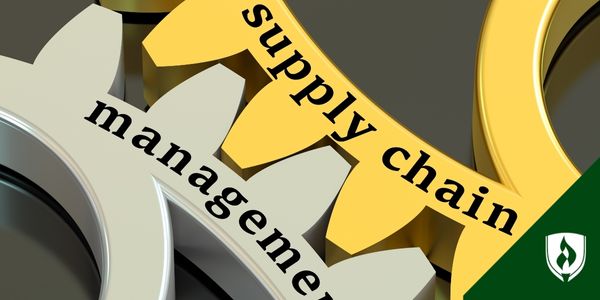How To Become a Supply Chain Manager
10/07/2025

Think about everything you use every day: Your clothes, your groceries, your tech. None of it would reach you without a well-oiled supply chain.1 At the heart of that system are supply chain managers, the people who keep goods moving, solve problems, and make sure everything runs smoothly from start to finish.
If you want to step into this role, start by building a strong foundation2 in business and logistics. Focus on developing both technical skills, like analyzing data and managing inventory, and leadership skills, like collaborating across teams and making decisions under pressure. Supply chains are constantly evolving1 and are driven by globalization, new technologies, and sustainability efforts. The key is to be adaptable, proactive, and ready to tackle challenges.
What Does a Supply Chain Manager Do?
Supply chain managers typically oversee2 the entire journey of goods, from raw materials to finished products reaching customers. They coordinate planning, sourcing, production, and delivery while managing supplier issues, customer concerns, inventory, and performance measurement. Their role is essential for aligning supply with demand, reducing risks, and supporting a company’s bottom line.
Supply chain managers combine technical expertise with leadership skills. They use2 tools like ERP systems, inventory management, and analytics to monitor operations, while also leading teams, collaborating across departments, and solving problems. This balance of strategy, technology, and people skills makes them critical to the success of modern businesses.
Build a Strong Foundation With Education
While there are multiple ways to enter the supply chain industry, a strong educational3 background in supply chain management or a related business field can give you the supply chain knowledge, technical skills, and business processes expertise needed for long-term success.
Rasmussen University’s Supply Chain and Logistics Management Program
Rasmussen University’s online bachelor’s degree in Supply Chain and Logistics Management is designed3 to help students develop skills for entry-level jobs and management positions in logistics and supply chain. This program blends business administration, operations management, and logistics management coursework with practical applications, making it ideal for those looking to become a supply chain manager.
Students learn supply chain strategy through courses3 such as:
- Procurement and Supplier Relations focuses on effective sourcing, bidding, negotiating, and supplier selection strategies through real-world supply chain and logistics scenarios.
- Supply Chain Risk and Compliance explores global regulatory requirements and teaches how to evaluate and manage risks related to logistics, trade, environmental, and safety compliance.
- Transportation and Distribution Management examines transportation and distribution operations with an emphasis on selecting efficient modes that balance customer needs and overall supply chain performance.
Because it’s an online degree program, Rasmussen’s program3 allows students to balance coursework with work or family commitments. This flexibility makes it possible for aspiring supply chain managers to gain practical experience while earning a degree.
Rasmussen University’s Supply Chain and Logistics Management program equips students with practical skills to prepare for a range of supply chain roles.
Key areas of focus include:3
- Apply Business Functions: Develop and implement lean, end-to-end processes and tools that enhance efficiency, create value, and satisfy customers throughout the supply chain.
- Efficiency Through Technology: Use business analytics, supply chain information systems, and data analysis to inform procurement decisions and strengthen professional relationships.
- Real-World Experience: Gain hands-on experience through case studies and projects, preparing for roles in local and global supply chain management, operations planning, and logistics.
- Career Confidence: May help students build the knowledge and experience needed for professional certifications such as the APICS® CSCP, providing a strong foundation as you enter the workforce.
Rasmussen’s supply chain and logistics management program3 aligns with industry standards and may provide the knowledge that supports preparation for the APICS® Certified Supply Chain Professional (CSCP) exam, a widely recognized certification that demonstrates expertise in supply chain processes, strategy, and operations, while an accelerated Master’s pathway allows students to take one MBA course as part of their bachelor’s degree to advance leadership opportunities and career growth.
Gaining Experience
Education provides the foundation, but experience is what helps you apply supply chain knowledge to real-world challenges. Many supply chain managers begin their careers in entry-level positions3 such as supply chain analyst, logistician, or logistics analyst. These roles allow you to gain valuable experience in data analysis, inventory management, demand planning, and logistics management.
From there, professionals often advance into mid-level positions3 like logistics manager, logistics engineer, or operations manager, where they can practice leadership skills, manage inventory, and oversee teams.
One effective way to stand out is to join professional organizations such as the Association for Supply Chain Management (ASCM)4 or the International Society of Logistics.5 Membership is one way to help you keep up with industry trends, expand your professional network, and access resources for certifications and continuing education.
Skills You’ll Need To Become a Supply Chain Manager
Becoming a supply chain manager requires a wide range of skills, and the list below6 highlights just a few of the most important qualities that professionals in this field rely on every day.
- Awareness & Customer Focus: Understand business goals and prioritize customer needs.
- Integrity & Professionalism: Demonstrate trustworthiness and consistency.
- Communication & Collaboration: Build relationships, influence others, and work effectively in teams.
- Problem Solving & Decision Making: Analyze situations and choose the best solutions.
- Creativity & Innovation: Improve processes and turn ideas into action.
- Planning & Project Management: Organize resources and achieve goals on time and within budget.
- Technology & Continuous Learning: Apply tools to optimize operations and adapt to change.
Professional Certifications
Professional certifications7 can help supply chain professionals validate their expertise, expand their knowledge, and stand out in a competitive job market. These credentials provide structured training and recognition, showing employers that you have the skills to manage complex supply networks, optimize operations, and drive efficiency across the supply chain.
Available certifications include:
- Certified Supply Chain Professional (CSCP): Gain broad supply chain knowledge to advance your career and lead superior supply networks.
- Certified in Planning and Inventory Management (CPIM): Demonstrate ability to handle demand variation, risk, and inventory control.
- Certified in Logistics, Transportation and Distribution (CLTD): Optimize transportation and distribution for more efficient supply chains.
- Certified in Transformation for Supply Chain (CTSC): Develop strategic skills to evolve, adapt, and transform supply networks.
Job Outlook for Supply Chain Managers
According to U.S. Bureau of Labor Statistics Labor Statistics, employment for logisticians is projected to grow8 19% from 2023 to 2033, faster than the average for all occupations, reflecting the increasing importance of supply chain strategy in a global economy.
Logisticians may work9 in a variety of industries, including:
- Manufacturing (23%)
- Professional, scientific or technical services (16%)
- Federal government (15%)
- Managing companies or enterprises (9%)
- Wholesale trade (9%)
Future Trends in Supply Chain Management
The supply chain industry is constantly changing, and supply chain management professionals must stay adaptable. The future of supply chain management in 202510 is being shaped by a combination of advanced technologies, evolving global dynamics, and a focus on resilience and agility. According to ASCM’s Top 10 Supply Chain Trends Report, organizations are increasingly leveraging artificial intelligence (AI), big data, and digital integration to enhance efficiency, improve decision-making, and optimize operations across industries. Cybersecurity, connectivity, and visibility are also critical priorities, helping supply chains protect sensitive information, track products, and ensure reliable delivery in complex, interconnected networks.
Industry-specific trends10 highlight how these technologies and strategies are applied in practice. For example, AI is transforming warehousing and logistics, big data is driving analytics in the automotive sector, and digital connectivity is reshaping retail operations. Other key areas of focus include strategic sourcing and supplier management in industrial manufacturing, workforce evolution in aerospace, and risk management in consumer packaged goods. Staying ahead of these trends allows professionals to develop the skills needed for a rapidly changing supply chain landscape and enables organizations to innovate, mitigate risks, and remain competitive.
Start Your Supply Chain Management Journey
Learning how to become a supply chain manager involves more than just studying logistics. It also requires developing3 business management, leadership, and problem-solving skills to manage supply chain activities across industries.
With the support of programs like Rasmussen University’s online3 bachelor’s degree in Supply Chain and Logistics Management, aspiring professionals can gain valuable experience, master key skills, and prepare for a career in a field that continues to grow and evolve.
APICS® is a registered trademark of Association for Supply Chain Management, Inc.
1Association for Supply Chain Management, “Supply Chain Management,” available at https://www.ascm.org/topics/supply-chain-management/ (visited Aug. 20, 2025).
2Association for Supply Chain Management, “Supply Chain Manager Overview,” available at https://www.ascm.org/globalassets/ascm_website_assets/docs/supply-chain--manager-overivew.pdf (visited Aug. 20, 2025).
3 Rasmussen University, “Supply Chain and Logistics Management,” available at https://www.rasmussen.edu/degrees/business/supply-chain-and-logistics-management/ (visited Aug. 20, 2025).
4Association for Supply Chain Management, available at https://www.ascm.org/ (visited Aug. 20, 2025).
5Sole, “About SOLE,” available at http://www.sole.org/about.asp (visited Aug. 20, 2025).
6Association for Supply Chain Management, “Supply Chain Career Skills,” available at https://www.ascm.org/membership-community/career-resources/supply-chain-career-skills/ (visited Aug. 20, 2025).
7Association for Supply Chain Management, “Certifications & Credentials,” available at https://www.ascm.org/learning-development/certifications-credentials/ (visited Aug. 20, 2025).
8Bureau of Labor Statistics, U.S. Department of Labor, “Logisticians – Job Outlook,” available at https://www.bls.gov/ooh/business-and-financial/logisticians.htm#tab-4 (visited Aug. 20, 2025). Employment conditions in your area may vary.
9Bureau of Labor Statistics, U.S. Department of Labor, “Logisticians – Duties & Responsibilities,” available at https://www.bls.gov/ooh/business-and-financial/logisticians.htm#tab-3 (visited Aug. 20, 2025). Employment conditions in your area may vary.
10Association for Supply Chain Management, “Top 10 Supply Chain Trends in 2025,” available at https://www.ascm.org/making-an-impact/research/top-10-supply-chain-trends-in-2025/ (visited Aug. 20, 2025).



